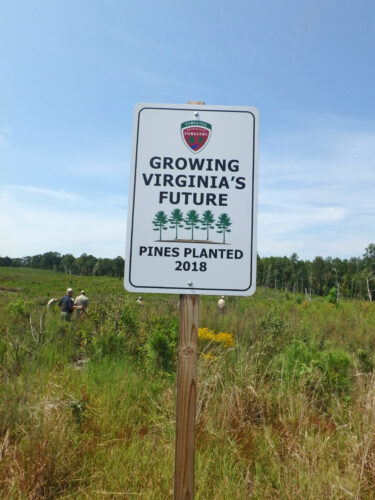
Developing the Next Forest
Trees grow naturally in Virginia soils and they have been for generations. Wherever there is sunlight, soil, water, and some growing space, trees will eventually find a place to grow. Some trees that need full sunlight and are the first trees to grow in an open area are called “pioneer” tree species. These pioneers usually have lightweight seeds that are easily blown by the wind and once they become established, they grow fast and occupy the open space as quickly as possible. But since they grow quickly at the beginning, they don’t usually live as long as other trees that come later in the process, known as forest succession. The process ultimately leads toward a climax forest. Tree species found in a climax forest don’t usually require full sunlight to grow and often begin their lives slowly, underneath and around the pioneer trees. Then when the pioneer trees begin to die and fall out of the forest, the climax trees will take over and can live for hundreds of years.
Over the years, humans have learned how to mimic the natural development of forests and how to better work within the natural process to produce lumber and other forest products more quickly. One way of speeding up the natural process is by preparing a harvested site and then planting tree seedlings, which is called “reforestation”. The most common reforestation practices aim to promote the growth of pine seedlings, one of the pioneer trees. Most pine seedlings need full sunlight, so the harvested site needs to be prepared, often by applying herbicides, prescribed burning, or using bulldozers to reduce the ability for other plants to compete with the planted pine seedlings. Once the site is prepared, good genetic quality pine seedlings can be planted.
Site preparation can also be used to prepare a site to enhance naturally seeded hardwood trees or sprouts. This site preparation is used to promote more valuable hardwood seedlings for wildlife, recreation, aesthetics, or timber production.
Financial Assistance for Reforestation
Financial assistance is available for growing pines through the Virginia Reforestation of Timberlands (RT) Program, funded by the forest industry in Virginia (Virginia Forest Products Tax) with matching funds from the Commonwealth of Virginia’s General Fund.
A variety of other financial assistance programs are available through DOF and partner agencies to assist landowners with reforestation and forest management activities.
Explore All Financial Assistance Programs
Get assistance with reforesting your land.
Additional Resources
| Image | Title | ID | Description | Date | Content Type | View | hf:tax:document-category | hf:tax:Media |
|---|---|---|---|---|---|---|---|---|
 | Reforestation of Timberlands Program – Cost-Share Assistance for Growing Pines | FT0020 | Forestry topic information sheet provides information about the Reforestation of Timberlands Program (RT Program), including an overview and information about the projects and payment rates for various covered activities. | 05/01/2025 | Publication | View | forest-management | publication |
| Hardwood Planting Guide | P00137 | Brochure illustrates and explains proper planting techniques for planting bare-root hardwood seedlings. Printed copies available. | 08/12/2024 | Publication | View | nurseries | publication | |
| Pine Planting Guide | P00117 | Brochure illustrates and explains proper planting techniques for planting bare-root pine seedlings. Printed copies available. | 08/12/2024 | Publication | View | nurseries | publication | |
 | Growing Loblolly Pine for Profit – Productivity and Financial Implications of Three Pine Competition Control Prescriptions | FT0033 | Forestry topic information sheet provides information about growing pine trees for profit based on research, comparing three possible competition control scenarios, resulting volume growth, financial projections and the timing of the practices. | 03/01/2018 | Publication | View | forest-management | publication |
 | Best Practices for Establishing Eastern White Pine – Based Upon Years of Research | FT0023 | Forestry topic information sheet provides information about best practices to be used in establishing Eastern white pine to encourage the best possible survival. | 08/01/2014 | Publication | View | forest-management | publication |
 | The Value of Pine Production – An Analysis of Investment | FT0021 | Forestry topic information sheet discusses the value of producing pines, including starting with a plan, growing pines, pine as an investment, and getting started. | 06/01/2014 | Publication | View | forest-management | publication |
 | Reforesting Cutover Timberland – Pine… A Good Investment | FT0004 | Forestry topic information sheet provides guidance to landowners about reforesting their cutover timberland, including planning, site preparation, planting, and checking survival. Printed copies available. | 11/01/2011 | Publication | View | forest-management | publication |
 | Facts About Low-Density Plantings of Loblolly Pine – Advantages of Planting Fewer Trees Per Acre | FT0003 | Forestry topic information sheet provides guidance to landowners about low-density planting for loblolly pine, including forest health, thinnings, wood quality, and return on investment. | 12/01/2008 | Publication | View | forest-management | publication |
Contact Us
DOF foresters can assist you with reforesting your land, contact your local DOF forester.
For more information or questions, e-mail us or use our contact form.
